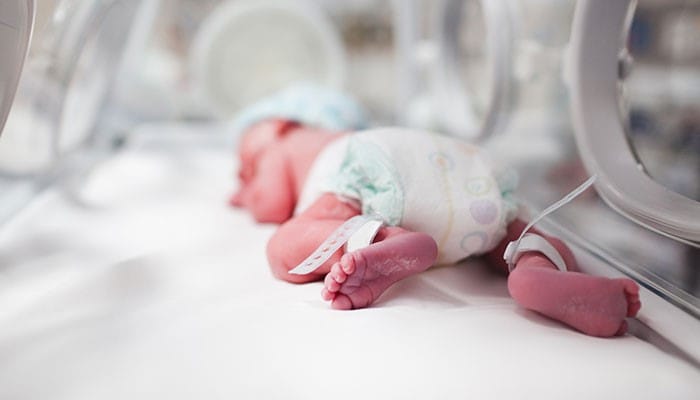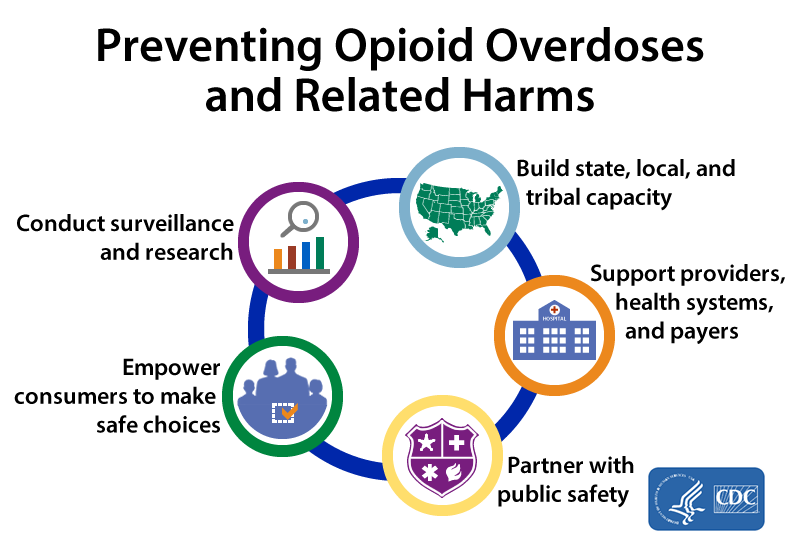Prenatal Opioid and Substance Exposure
Neonatal Abstinence Syndrome and Other Infant and Child Outcomes Related to Prenatal Opioid and Substance Exposure: NCBDDD Activities
As a part of CDC’s 5 key strategies for preventing opioid overdoses and opioid-related harms, CDC’s National Center on Birth Defects and Developmental Disabilities (NCBDDD) is working to address the impact of the opioid crisis on women who are pregnant, infants, and children. NCBDDD aims to better understand neonatal abstinence syndrome (NAS) and other health outcomes in infants and children related to substance use in pregnancy. NCBDDD uses findings to improve the care of mothers and their children and help them thrive.
Learn more about opioid use during pregnancy.
Learn more about polysubstance use during pregnancy.
Read the latest data and statistics about opioid use during pregnancy and NAS.
NCBDDD’s Activities to Support CDC’s 5 Key Strategies
Conduct surveillance and research
Neonatal Abstinence Syndrome (NAS) Surveillance
CDC works with the Council of State and Territorial Epidemiologist to provide technical assistance to state, local, tribal, or territorial jurisdictions to rapidly implement new standardized tracking criteria for NAS. Using consistent criteria to define NAS for public health reporting helps ensure quality data are collected and women and their babies are connected with needed services.
MAT-LINK: MATernaL and Infant NetworK to Understand Outcomes Associated with Medication for Opioid Use Disorder during Pregnancy
Through funding from the Assistant Secretary for Planning and Evaluation’s Patient-Centered Outcomes Research Trust Fund (PCOR-TF), CDC’s National Center on Birth Defects and Developmental Disabilities established MAT-LINK. MAT-LINK is a surveillance system monitoring maternal, infant, and child health outcomes associated with medication for opioid use disorder during pregnancy. Currently, MAT-LINK collects data from seven clinical sites: Boston Medical Center Corporation, Kaiser Foundation Research Institute (Center for Health Research-Northwest), The Ohio State University, University of New Mexico, University of Rochester, University of South Florida, and University of Utah. Project objectives include
- Developing a data platform to collect linked maternal and infant data; and
- Comparing health outcomes across medication for opioid use disorder regimens to inform best practice guidelines for people who are pregnant and infants.
Examining Longer-term Outcomes among Children with NAS
A pilot study from the Tennessee Department of Health, supported by CDC and March of Dimes, looked at developmental outcomes among children with a history of NAS. They found that these children were more likely to have a developmental delay or speech or language impairment in early childhood compared to children without a history of NAS. This was the first study to look at educational outcomes among children with a history of NAS in the United States. Additional research is needed to better understand the longer-term outcomes of prenatal opioid exposure for children with a history of NAS.
Evaluating Possible Associations between Prescription Opioid Use during Pregnancy and Birth Defects

In two case-control studies of birth defects (one using data from the National Birth Defects Prevention Study and the other using data from the Slone Birth Defects Study), researchers identified possible associations between exposure to prescription opioid medication just before or during early pregnancy and the occurrence of certain birth defects. In a review article summarizing existing literature (including the two aforementioned articles), researchers identified birth defects that may be related to prescription and illicit opioid use or misuse during pregnancy, including
Additionally, in a 2019 study, researchers found that the number of babies born with gastroschisis (a birth defect of the abdominal wall) was higher in U.S. counties with high opioid prescription rates than in counties with low opioid prescription rates. More research is needed to determine if prescription and illicit opioid exposure in pregnancy increases the risk of birth defects.
Evaluating Possible Associations between Opioid Use during Pregnancy and Developmental Disabilities
An analysis of the Study to Explore Early Development (SEED) found that mothers who were prescribed opioids just before becoming pregnant were more likely to have a child with autism spectrum disorder or a child with other developmental disabilities and some autism symptoms. This study is among the first to look at associations between the prescribing of opioids during pregnancy and autism spectrum disorder and other developmental disabilities. More research is needed to better understand developmental outcomes among children whose mothers were exposed to prescription or illicit opioids up to 3 months before and during pregnancy.
Monitoring and Reporting the Occurrence of Prescription Opioid Use in Women of Reproductive Age and Women who are pregnant
NCBDDD researchers used data from two large insurance claim datasets to look at opioid prescriptions filled at outpatient pharmacies by women of reproductive age. Researchers found that on average each year during 2008–2012, 28% of women with private health insurance and 39% of women with Medicaid filled a prescription from a healthcare provider for an opioid medication. The most commonly prescribed opioids were hydrocodone, codeine, and oxycodone. In addition, the frequency of opioid prescription claims was consistently higher among Medicaid-insured women than commercially insured women. More work is needed to promote interventions to reduce opioid prescriptions among women when safer alternative treatments are available.
Build state, local, and tribal capacity
Evaluation of State-mandated Reporting of NAS in Six States
NCBDDD collaborated with other CDC and HHS staff to identify laws that mandate NAS reporting for public health surveillance and evaluate their impact. These laws helped states estimate the number of babies diagnosed with NAS in their area. They also helped to identify opportunities for treatment and prevention for mothers and babies and plan for needed services. These findings can help other states thinking about laws requiring NAS reporting for public health surveillance.
Rapid Assistance with Data Collection and Analysis in Pennsylvania
The Pennsylvania Department of Health requested the assistance of NCBDDD, in the form of an Epi-Aid, to assess the quality of hospital data on NAS reported in Pennsylvania. To accomplish these objectives, data from the medical records of about 500 infants with possible NAS (along with medical records for mothers of infants meeting Pennsylvania’s NAS case definition) were collected at five hospitals across Pennsylvania in 2019. Analyses are ongoing.
Local Health Department Surge Support
Through NCBDDD’s Local Health Department Initiative, a contractual field assignee was placed in Allegheny County, Pennsylvania. In this role, she supported the county health department in responding to the local opioid crisis. NCBDDD and the Allegheny County Health Department seek to improve public health outreach to mothers and their infants affected by the opioid crisis. Through a partnership with the Association of State and Territorial Health Officials, and in collaboration with CDC’s Division of Reproductive Health, NCBDDD is working to place additional contractual assignees in selected local health departments to provide surge support to respond to the opioid crisis.
The Opioid Use Disorder, Maternal Outcomes, and Neonatal Abstinence Syndrome Initiative (OMNI)
The Opioid Use Disorder, Maternal Outcomes, and Neonatal Abstinence Syndrome Initiative (OMNI) Learning Community was developed through a partnership with the Association of State and Territorial Health Officials, and in collaboration with CDC’s Division of Reproductive Health. NCBDDD placed additional contractual assignees in selected local health departments within OMNI to provide surge support to respond to the opioid crisis
Support providers, health systems, and payers
Clinical and Public Health Partnerships
NCBDDD collaborates with clinical and public health organizations to address the impact of the opioid and substance use crisis on women who are pregnant, infants, and children:
- American Academy of Pediatrics (AAP)
- American College of Obstetricians and Gynecologists (ACOG)
- Association of Maternal and Child Health Programs (AMCHP)
- Association of Public Health Laboratories (APHL)
- Association of State and Territorial Health Officials (ASTHO)
- Council of State and Territorial Epidemiologists (CSTE)
- March of Dimes
- National Association of County and City Health Officials (NACCHO)
- National Organization on Fetal Alcohol Syndrome (NOFAS)
Empower consumers to make safe choices
Treating for Two
NCBDDD and partners began Treating for Two to improve the health of women and babies by identifying the safest treatment options for common conditions experienced before, during, and after pregnancy. With this initiative, CDC aims to do the following:
- Support research about health outcomes related to medicine use during pregnancy
- Provide guidance on medicine use in pregnancy
- Help women and healthcare professionals make treatment decisions together based on the best available information
Communicating with Healthcare Providers and Women who are pregnant: Reducing Stigma
Communication around pregnancy and opioid use can be challenging. Therefore, it is important for communicators to avoid words and messages that are stigmatizing or ineffective. NCBDDD has collaborated with March of Dimes in qualitative studies around communication and messaging for healthcare providers and women who are pregnant. We are learning more about the knowledge and attitudes of women and healthcare providers regarding opioid use during pregnancy and NAS, as well as perceptions of harm from medicine and other substances.
Partner with public safety
Collaboration with Child Welfare around Prenatal Alcohol and Other Drug Exposures
NCBDDD collaborates with the Children’s Bureau of the Administration for Children and Families (ACF) to improve the health and developmental outcomes of children with prenatal substance exposures in the child welfare system by promoting appropriate identification, referrals, interventions, and education. This project also aims to reduce the risk of repeating the cycles of abuse and neglect and build the infrastructure to monitor the type and resources needed to care for this population.
Publications
Public Health Surveillance of Prenatal Opioid Exposure in Mothers and Infants
Educational Disabilities Among Children Born With Neonatal Abstinence Syndrome
Evaluation of State-Mandated Reporting of Neonatal Abstinence Syndrome — Six States, 2013–2017
Maternal Use of Opioids During Pregnancy and Congenital Malformations: A Systematic Review
Opioid Prescription Claims Among Women of Reproductive Age–United States, 2008—2012
Periconceptional Use of Opioids and the Risk of Neural Tube Defects
Maternal Treatment with Opioid Analgesics and Risk for Birth Defects
For additional resources and information related to opioid exposure during pregnancy, please visit CDC’s Opioid Use During Pregnancy webpages.
